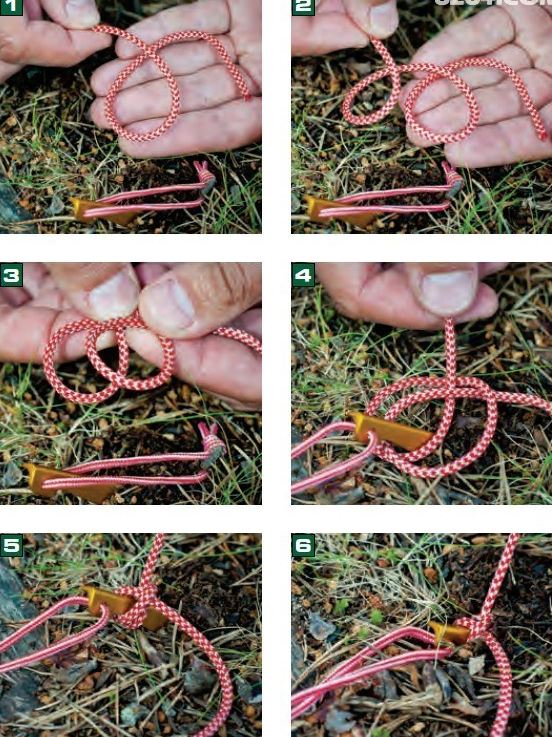The form of the tarp varies from place to place, but the knot is always the same.
Please pay attention to the type of rope selection, can not choose too smooth rope as a hammock rope.
To build the tarp, please pay attention to fixing and shaping, shaping to make the tarp present a specific shape to meet different needs.
There are four principles for building a tarp.
1. The steeper the slope of the tarp, the better the waterproof, and not easy to accumulate water.
2. They make the tarp tighter, the less shaking in the wind, and the less noise.
3. Raise the height of the tarp in addition to the support pole and the use of trees or other fixed points, according to local conditions.
4. as far as possible to use, easy to knot, adjust, and solve the knot.
Only the last point is discussed here.
There are two common hammock tarp setup models.
1. ” A ” type
That is the center ridge roof type. The main rope of the central axis is raised high, and the side view resembles the word “A.”
This is the most common form of shelter. Height adjustable, the bottom can be attached to the ground. It is windproof and protects from rain and snow.
2. ” / ” type
That is the single slope type. The tarp is elevated on one side, the whole canopy tilted towards the other side, and the side view is similar to the ” / ” character.
Single slope type can also be close to the ground, conducive to fire heating. Or use two tarps that rely on each other; the smoke can be circulated from the middle, two tarps at the same time to form a heat reflection, with the use of fire.
How to set up an “A” shape hammock tarp?
The center ridge roof-style hitching method is usually divided into four steps:
- Step 1: hang one end of the main rope (central axis) on the tree, and then put up the tarp.
- Step 2: put the other end of the main rope fixed on the tree. (The first two steps are to fix the main axis.)
- Step 3: fix the canopy on the main axis of the main rope.
- Step 4: fix the canopy corners and the ground peg.
Explore the terrain first, anticipate the shape of the tarp and the area it will occupy, while observing the fixing points and estimating the rope length.
When you start building, set aside enough rope length. The frequent problem is that there is not enough rope. My regular practice is to leave six 4m wind ropes on the 3Mx3M tarp in advance, and then bring two more bundles of 10m rope.
When closing the canopy, I generally rarely fold the canopy, but directly into the bag to save time and trouble. If folded, pay attention to exhaust the air.
How to make the knot for the hammock tarp?
1. Tarp first knot.
Simple, fast, and firm, easy to untie the knot. Please note the normality of the technique.
- Method one
The excess rope end can be snapped into the rope loop to form protection. This knot can also be fixed in the tarp corner or side of the fixed loop ring. This knot is also a hammock construction knot.

- Method two
A single set of knots. More simple than the first knot.

2. Tarp second knot.
This knot tightens the main rope
- Method one
Use the second loop of rope around the main rope again. The disadvantage is not tight enough

- Method two
This knot can be adjusted for elasticity and is extremely convenient. If you want to learn just one knot to build a tarp, that’s it!

3. Tarp third rope knot.
The purpose is to fix the canopy fabric on the main rope of the spindle. Free adjustment of the tarp on the main rope facilitates tautness and can be fixed when under pressure.
- Method one
The method is to use the rope loop around the main rope three times and then set the front of the tarp ring fixed on the main rope. Convenient sliding and load-bearing will lock; the disadvantage is doing a rope loop or with fast hanging, slightly troublesome.

- Method two
Wrap the rope around the main rope for more than three turns, then come back with a backhand knot overhand fixed. Load-bearing can be locked; not load-bearing can slide.

4. Tarp fourth knot.
The tarp’s first knot should be used to connect the peg and the rope, but some alternatives can be used.
- Method one
Easy and simple, easy to knot and solve.

- Method two
Universal knot

- Method three
Double set of knots. This knot can not directly adjust the tautness of the rope, not stable enough. But it works well on the double extension of the support rod.


